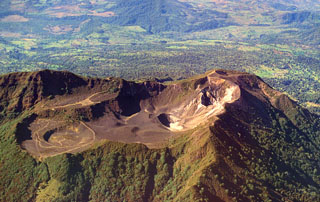Report on Turrialba (Costa Rica) — 8 February-14 February 2017
Smithsonian Institution / US Geological Survey
Weekly Volcanic Activity Report, 8 February-14 February 2017
Managing Editor: Sally Sennert.
Please cite this report as:
Global Volcanism Program, 2017. Report on Turrialba (Costa Rica) (Sennert, S, ed.). Weekly Volcanic Activity Report, 8 February-14 February 2017. Smithsonian Institution and US Geological Survey.
Turrialba
Costa Rica
10.025°N, 83.767°W; summit elev. 3340 m
All times are local (unless otherwise noted)
OVSICORI-UNA reported that at 1610 on 8 February an ash plume rose 300 m above Turrialba's active vent and drifted N. An event at 1531 on 10 February also produced an ash plume but inclement weather prevented estimates of the plume height. During 11-12 February variable amplitude tremor was detected, and at night hot blocks ejected from the vent landed in Cráter Central. Several events on 13 February (at 0255, 0305, 0415, and 1459) produced ash plumes that rose as high as 1 km and drifted N, NW, and W. Several small ejections of incandescent material fell around the active crater during the early morning. On 14 February continuous emissions of gas and steam with low ash content were visible. A strong sulfur odor was reported in San Pablo de Oreamuno (25 km SW).
Geological Summary. Turrialba, the easternmost of Costa Rica's Holocene volcanoes, is a large vegetated basaltic-to-dacitic stratovolcano located across a broad saddle NE of Irazú volcano overlooking the city of Cartago. The massive edifice covers an area of 500 km2. Three well-defined craters occur at the upper SW end of a broad 800 x 2200 m summit depression that is breached to the NE. Most activity originated from the summit vent complex, but two pyroclastic cones are located on the SW flank. Five major explosive eruptions have occurred during the past 3500 years. A series of explosive eruptions during the 19th century were sometimes accompanied by pyroclastic flows. Fumarolic activity continues at the central and SW summit craters.
Source: Observatorio Vulcanologico y Sismologico de Costa Rica-Universidad Nacional (OVSICORI-UNA)

